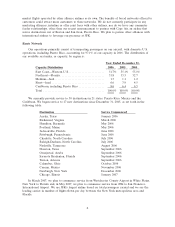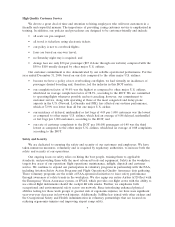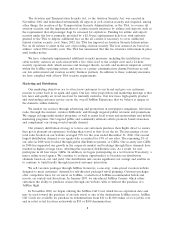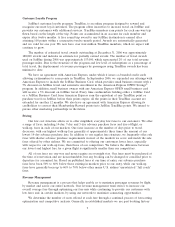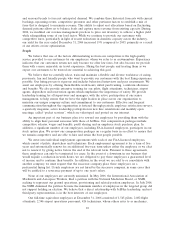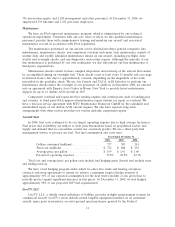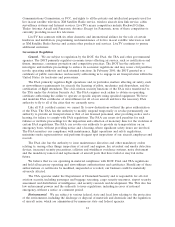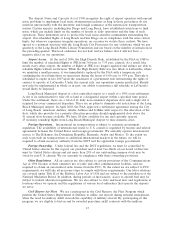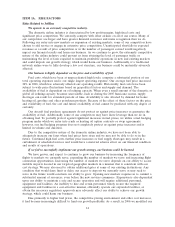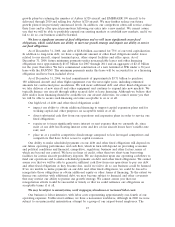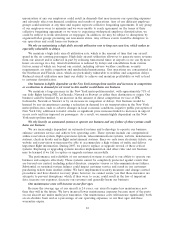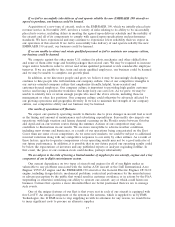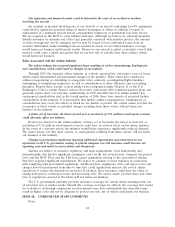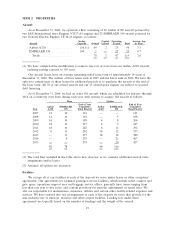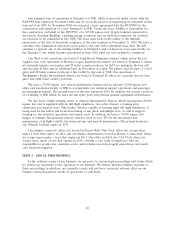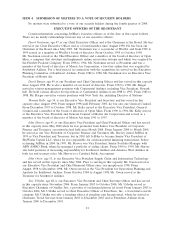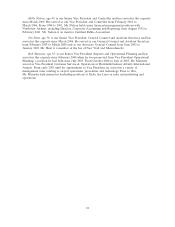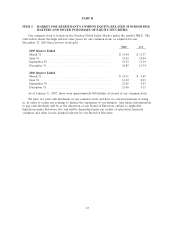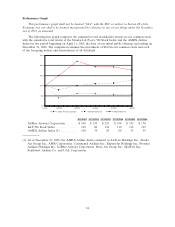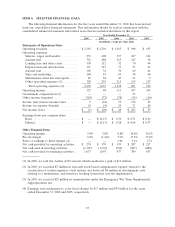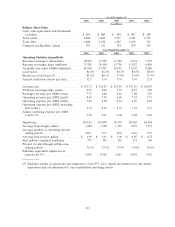JetBlue Airlines 2006 Annual Report Download - page 26
Download and view the complete annual report
Please find page 26 of the 2006 JetBlue Airlines annual report below. You can navigate through the pages in the report by either clicking on the pages listed below, or by using the keyword search tool below to find specific information within the annual report.unionization of any our employees could result in demands that may increase our operating expenses
and adversely affect our financial condition and results of operations. Any of our different employee
groups could unionize at any time and require separate collective bargaining agreements. If any group
of our employees were to unionize and we were unable to reach agreement on the terms of their
collective bargaining agreement or we were to experience widespread employee dissatisfaction, we
could be subject to work slowdowns or stoppages. In addition, we may be subject to disruptions by
organized labor groups protesting our non-union status. Any of these events would be disruptive to
our operations and could harm our business.
We rely on maintaining a high daily aircraft utilization rate to keep our costs low, which makes us
especially vulnerable to delays.
We maintain a high daily aircraft utilization rate, which is the amount of time that our aircraft
spend in the air carrying passengers. High daily aircraft utilization allows us to generate more revenue
from our aircraft and is achieved in part by reducing turnaround times at airports so we can fly more
hours on average in a day. Aircraft utilization is reduced by delays and cancellations from various
factors, many of which are beyond our control, including adverse weather conditions, security
requirements, air traffic congestion and unscheduled maintenance. Our operations are concentrated in
the Northeast and Florida areas, which are particularly vulnerable to weather and congestion delays.
Reduced aircraft utilization may limit our ability to achieve and maintain profitability as well as lead
to customer dissatisfaction.
Our business is highly dependent on the New York metropolitan market and increases in competition
or a reduction in demand for air travel in this market would harm our business.
We maintain a large presence in the New York metropolitan market, with approximately 71%of
our daily flights having JFK, LaGuardia, Newark or Stewart as either their destination or origin. Our
business could be harmed by an increase in the amount of direct competition we face at JFK,
LaGuardia, Newark or Stewart or by an increase in congestion or delays. Our business would be
harmed by any circumstances causing a reduction in demand for air transportation in the New York
metropolitan area, such as adverse changes in local economic conditions, negative public perception of
New York City, additional terrorist attacks or significant price increases linked to increases in airport
access costs and fees imposed on passengers. As a result, we remain highly dependent on the New
York metropolitan market.
We rely heavily on automated systems to operate our business and any failure of these systems could
harm our business.
We are increasingly dependent on automated systems and technology to operate our business,
enhance customer service and achieve low operating costs. These systems include our computerized
airline reservation system, flight operations system, telecommunications systems, website, maintenance
systems, check-in kiosks and in-flight entertainment systems. Since we only issue electronic tickets, our
website and reservation system must be able to accommodate a high volume of traffic and deliver
important flight information. During 2007, we plan to replace or upgrade several of these critical
systems. Replacing or upgrading systems involves implementation and other risks and our business
may be harmed if we fail to replace or upgrade systems successfully.
The performance and reliability of our automated systems is critical to our ability to operate our
business and compete effectively. These systems cannot be completely protected against events that
are beyond our control, including natural disasters, computer viruses or telecommunications failures.
Substantial or sustained system failures could impact customer service and result in our customers
purchasing tickets from another airline. We have implemented security measures and change control
procedures and have disaster recovery plans; however, we cannot assure you that these measures are
adequate to prevent disruptions, which, if they were to occur, could result in the loss of important
data, increase our expenses, decrease our revenues and generally harm our business.
Our maintenance costs will increase as our fleet ages.
Because the average age of our aircraft is 2.6 years, our aircraft require less maintenance now
than they will in the future. We have incurred lower maintenance expenses because most of the parts
on our aircraft are under multi-year warranties. Our maintenance costs will increase significantly, both
on an absolute basis and as a percentage of our operating expenses, as our fleet ages and these
warranties expire.
16


